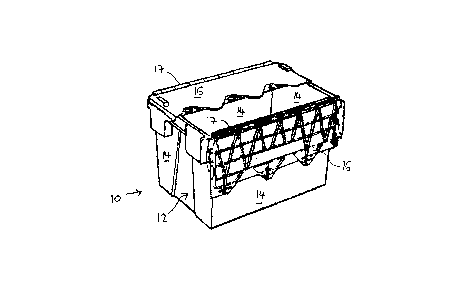Some of the information on this Web page has been provided by external sources. The Government of Canada is not responsible for the accuracy, reliability or currency of the information supplied by external sources. Users wishing to rely upon this information should consult directly with the source of the information. Content provided by external sources is not subject to official languages, privacy and accessibility requirements.
Any discrepancies in the text and image of the Claims and Abstract are due to differing posting times. Text of the Claims and Abstract are posted:
| (12) Patent Application: | (11) CA 2233199 |
|---|---|
| (54) English Title: | CONTAINER |
| (54) French Title: | CONTENANT |
| Status: | Deemed Abandoned and Beyond the Period of Reinstatement - Pending Response to Notice of Disregarded Communication |
| (51) International Patent Classification (IPC): |
|
|---|---|
| (72) Inventors : |
|
| (73) Owners : |
|
| (71) Applicants : |
|
| (74) Agent: | RICHES, MCKENZIE & HERBERT LLP |
| (74) Associate agent: | |
| (45) Issued: | |
| (22) Filed Date: | 1998-03-26 |
| (41) Open to Public Inspection: | 1998-09-27 |
| Availability of licence: | N/A |
| Dedicated to the Public: | N/A |
| (25) Language of filing: | English |
| Patent Cooperation Treaty (PCT): | No |
|---|
| (30) Application Priority Data: | ||||||
|---|---|---|---|---|---|---|
|
A container in which the lid 16 is attached to the body of the container
by a hinge arrangement. When the hinge arrangement is assembled, knuckles
30 on the lid 16 are interleaved with knuckles 20 formed along the upper edge
of the container walls. Each of the knuckles 20, 30 has an elongate bore formed
to receive a single hinge pin along the common line 22, 36. When the lid 16 is
closed, tab 34 projects through the socket 24 into the interior of the knuckle 20,
thereby preventing the hinge being pulled apart.
Contenant dont le couvercle (16) est rattaché au corps par un dispositif à charnières. Lorsque le dispositif à charnières est assemblé, des charnons (30) sur le couvercle (16) s'engagent entre les charnons (20) formés le long du bord supérieur des parois du contenant. Chaque charnon (20, 30) comporte un trou allongé formé de manière à recevoir une broche de charnière unique sur leur ligne commune (22, 36). Lorsque le couvercle (16) est fermé, la languette (34) fait saillie par un logement (24) à l'intérieur du charnon (20), ce qui empêche la charnière d'être séparée.
Note: Claims are shown in the official language in which they were submitted.
Note: Descriptions are shown in the official language in which they were submitted.

2024-08-01:As part of the Next Generation Patents (NGP) transition, the Canadian Patents Database (CPD) now contains a more detailed Event History, which replicates the Event Log of our new back-office solution.
Please note that "Inactive:" events refers to events no longer in use in our new back-office solution.
For a clearer understanding of the status of the application/patent presented on this page, the site Disclaimer , as well as the definitions for Patent , Event History , Maintenance Fee and Payment History should be consulted.
| Description | Date |
|---|---|
| Inactive: IPC from MCD | 2006-03-12 |
| Inactive: IPC from MCD | 2006-03-12 |
| Application Not Reinstated by Deadline | 2002-03-26 |
| Time Limit for Reversal Expired | 2002-03-26 |
| Deemed Abandoned - Failure to Respond to Maintenance Fee Notice | 2001-03-26 |
| Inactive: Single transfer | 1999-02-19 |
| Application Published (Open to Public Inspection) | 1998-09-27 |
| Classification Modified | 1998-07-30 |
| Inactive: First IPC assigned | 1998-07-30 |
| Inactive: IPC assigned | 1998-07-30 |
| Inactive: Courtesy letter - Evidence | 1998-06-16 |
| Filing Requirements Determined Compliant | 1998-06-10 |
| Inactive: Filing certificate - No RFE (English) | 1998-06-10 |
| Application Received - Regular National | 1998-06-08 |
| Abandonment Date | Reason | Reinstatement Date |
|---|---|---|
| 2001-03-26 |
The last payment was received on 2000-03-03
Note : If the full payment has not been received on or before the date indicated, a further fee may be required which may be one of the following
Please refer to the CIPO Patent Fees web page to see all current fee amounts.
| Fee Type | Anniversary Year | Due Date | Paid Date |
|---|---|---|---|
| Application fee - standard | 1998-03-26 | ||
| Registration of a document | 1998-03-26 | ||
| MF (application, 2nd anniv.) - standard | 02 | 2000-03-27 | 2000-03-03 |
Note: Records showing the ownership history in alphabetical order.
| Current Owners on Record |
|---|
| MCKECHNIE UK LIMITED |
| Past Owners on Record |
|---|
| STEPHEN CLIVE LOFTUS |